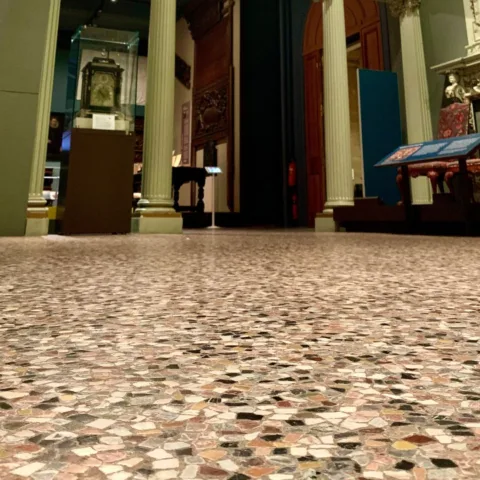The Bowes Museum Blog

Strong Roots: A Eulogy for a Tree
In the opening lines of her history of the Museum (John & Joséphine: The Creation of the Bowes Museum), Caroline Chapman gives a description of the approach from Newgate to the Museum’s doors. She writes:
‘Entering the fine wrought-iron gates, the visitor approaches the Museum by a semi-circular drive, passing en route the jagged limbs of a giant monkey-puzzle tree, planted there by the Museum’s founders in 1871.’
Visitors to the Museum since it opened in 1892 will no doubt have been struck by this tree, proudly overlooking the grounds, standing guard as one approaches up the left-hand driveway. Visitors of the past few weeks, however, will have been struck by a very different sight altogether: the totem-like trunk that stands where the monkey puzzle once stood. The tree, an endangered species native to South America, has sadly passed, but the archives reveal that this tree was an important part of John and Joséphine’s museum project.

The monkey puzzle as it appears today.
The meticulously kept documents relating to the Museum stored in the archive reveal the story of this tree, and also reveal its importance. We know from the accounts that the tree was purchased in 1871 for the princely sum of 15 guineas and 15 shillings. This single tree cost, at that point, more than any of the paintings John and Joséphine had bought for the Museum, even the pearls of the collection by El Greco or Goya! It was also the first tree planted in the grounds, and the lengths to which they went during the purchase (not to mention the price they were willing to pay) suggest it had a special significance for them.

Museum Land and Garden Account Book, covering 1865-1873, containing the details of the purchase of the araucaria, JB/6/3/1.
The tree was provided by a Mr Lane of Great Berkhampsted, Hertfordshire, whose business card is in the archive. The idea to purchase one of these trees for the Museum had clearly been conceived before July 1871 and entrusted to William Hutt, John’s step-father and MP for Hull. In a letter from Hutt dated July 4th 1871, he tells John of an acquaintance called Standish who had agreed to inspect the tree offered by Lane and to ascertain whether the tree would be able to withstand relocation to Barnard Castle. The outcome of this inspection was clearly positive, and Hutt reports that Standish thought Lane’s tree to be a ‘well grown and healthy specimen’, and that the price was ‘fair & moderate’.

Letter dated July 4th 1871 sent to John Bowes by William Hutt detailing the tree that would become the Museum’s monkey puzzle, JB/2/5/4/43.
John’s correspondence over the course of July reveals that the tree was often on his mind, which is astonishing given the context: the Bowes were taking refuge in London after the bloody events of the Franco-Prussian War and the subsequent Paris Commune, which only came to an end with the ‘semaine sanglante’, the Bloody Week that began on May 21st of that same year, and they were greatly concerned for the welfare of their vast collection that remained at their temporary exhibition space on Rue Blomet. After 2 and a half years away from Paris, John wrote in a letter to his agent, Ralph Dent on July 12th: ‘We have had enough of London, & are anxious to get away as soon as possible’. But even amongst all this furore, John’s letter still also addresses the tree, and his concern that it make its way to the Museum as soon as possible.
In the event, it was transported northwards by train, which it appears from the letters was quite the logistical nightmare, as the tree was too large to fit in one carriage. By July 17th, however, the tree had been installed in the grounds. A letter that bears this date written by John to Dent revels that he was ‘glad to hear the Araucaria got safe down & into the Ground’, and he goes on to ensure that it be cared for, leaving instructions for the head forester: ‘If it comes on dry weather Bewick must mind it is kept well watered’.

Business card of Lane & Sons, who sold the monkey puzzle to John and Joséphine in 1871, JB/6/3/3/8.
Perhaps John had a particular attachment to this type of tree. A letter from John’s agent in 1861 tells us that there were a number of monkey-puzzle trees at his family home at Streatlam, but the winter of that year was harsh, and the trees all perished. This specific genus of tree may well have had some sentimental value for him. It is clear from the correspondence that Joséphine, too, was attached to it, as a letter from 1872, a year after it was planted, shows Joséphine to be especially concerned that the tree thrive in its new environment. She is, John tells us, ‘anxious to know how the araucaria sent from London is going on’.

Letter from John Bowes to Ralph Dent, written from Paris in August 1872, in which he asks on behalf of Joséphine about the progress of the tree, JB/2/1/40/89.
Next year marks the 125th anniversary of the founding of the Museum. It is a shame, then, that this tree, so dear to the Bowes, didn’t quite make this significant milestone. Though since it was planted in 1871, the tree is indeed older than the Museum itself. The branchless trunk therefore stands as a fitting memorial. And thankfully one of the Museum’s curators had another monkey puzzle planted beside the original tree during a redevelopment of the gardens in the 1980s, an act for which our founders, especially now, would no doubt be thankful.

Photograph of the Bowes Museum taken in 1930 by Elijah Yeoman (1849-1930), in which the monkey puzzle appears prominently. 1997.46.243/ARC.
By James Illingworth, PhD Student, Library & Archives





